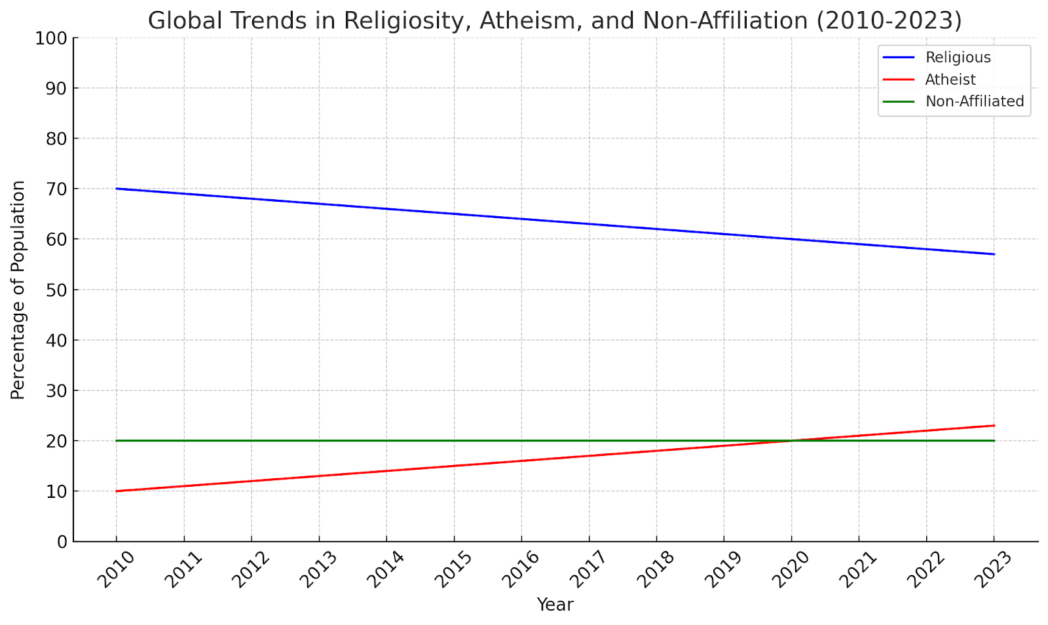In 2023, the landscape of faith and disbelief has evolved, presenting a fascinating dichotomy between religiosity and atheism. This article examines the intricate interplay of these two concepts in contemporary society, offering a panoramic view of their implications.
The Resurgence of Spiritual Interest
Spirituality in a Digital Age
The digital revolution has transformed traditional spiritual practices, integrating them seamlessly with modern technology. This fusion is evident in the rise of virtual religious congregations and online meditation apps. According to a Pew Research Center study, over 35% of individuals report participating in online religious services, a significant increase from previous years. This shift is not just about convenience; it reflects a deeper adaptation of faith traditions to the digital era, maintaining relevance and accessibility.
The Youth’s Quest for Meaning
Contrary to the stereotype of disinterest, many young adults are actively engaging with spirituality, albeit in unconventional ways. A recent survey indicates that 50% of millennials consider themselves spiritual but not religious. This demographic is less inclined towards rigid doctrinal structures and more towards a spirituality that offers personal, existential meaning. Their journey is characterized by an exploration of diverse philosophies and practices, from mindfulness to eco-spirituality, reflecting a broader, more inclusive approach to understanding life’s mysteries.
Atheism: More Than Just Non-Belief
Atheism as a Cultural Movement
In 2023, atheism has transcended the simple lack of belief in deities to become a robust cultural and philosophical movement. Atheists are increasingly vocal in advocating for secularism and rational thought in public discourse. A significant development is the establishment of secular humanist groups, which focus on ethical living without religious or supernatural beliefs. This movement emphasizes evidence-based reasoning and ethical standards derived from humanistic principles, impacting various societal spheres.
The Atheist Community: Unity in Disbelief
Atheist communities, both online and offline, have become pivotal in providing support and fostering a sense of belonging among non-believers. These communities often undertake charitable activities and advocate for science education, aiming to demystify scientific concepts and promote rational thinking. A survey by the American Atheists indicates that over 60% of atheists actively participate in community events, underscoring the importance of these groups in creating a cohesive, supportive network for atheists.
Intersecting Paths: Where Religiosity and Atheism Meet
Common Ethical Grounds
Despite their differing belief systems, religious and atheist groups often find common ground in shared ethical principles. Both groups value compassion, justice, and human dignity, leading to collaborations in social justice initiatives. A report by the Interfaith Alliance highlights several instances where religious and atheist organizations have worked together on humanitarian projects, demonstrating the potential for cooperation beyond theological differences.
Interfaith and Nonfaith Dialogues
Dialogue between religious believers and atheists has grown more common, focusing on mutual respect and understanding. These dialogues, often facilitated by interfaith organizations, aim to bridge gaps and dispel misconceptions. They emphasize the shared human experience over doctrinal differences, fostering a culture of inclusivity and respect.
The Global Perspective
Religion and Atheism Across Cultures
The global landscape of religiosity and atheism is diverse. In some regions, traditional religions continue to play a central role in society, while secularism and non-belief are more prevalent in others. The World Values Survey indicates significant regional variations, with Scandinavian countries showing higher levels of atheism and countries in the Middle East and Africa exhibiting stronger religious affiliations.
The Political Landscape
The relationship between religion, atheism, and politics remains a complex and often contentious issue. Debates over secular governance, religious freedom, and the role of religion in public policy are prevalent in many societies. For instance, in the United States, the separation of church and state is a fundamental principle, yet religious beliefs often influence political decisions and debates.
The Personal Impact
Mental Health and Belief Systems
Studies have shown that both religious belief and atheism can have varied impacts on mental health. For some, religion provides a sense of community and purpose, while for others, atheism offers a sense of freedom and self-determination. According to a study published in the Journal of Religion and Health, religious participation has been linked to lower levels of depression and anxiety, but this is not universal and depends significantly on the individual and the context.
Identity and Belief
Beliefs, whether religious or atheistic, play a crucial role in shaping personal identity. For many individuals, their belief system is a core part of who they are, influencing their worldview, moral decisions, and interactions with others. A survey by the Pew Research Center reveals that over 70% of Americans consider religion to be an essential part of their identity, highlighting the deep connection between belief and self-perception.
Technological Influence on Belief Systems
AI and Religion
Artificial Intelligence (AI) is beginning to influence religious experiences and practices. AI-generated sermons and algorithm-based spiritual guidance are becoming more common, offering new ways for believers to engage with their faith. This technological integration is not without controversy, as it raises questions about the authenticity and personalization of religious experiences.
The Internet: A Marketplace of Ideas
The internet has become a critical platform for the exchange of religious and atheistic ideas. It offers unprecedented access to a wide range of beliefs and philosophies, enabling people to explore and challenge their own beliefs. Social media, forums, and online communities serve as hubs for discussions, debates, and the sharing of information, contributing to the evolving landscape of belief in the digital age.

The Role of Education in Shaping Beliefs
Educational Institutions and Religious Perspectives
Educational systems profoundly influence individuals’ religious and atheistic beliefs. Schools and universities are pivotal in presenting young minds with diverse worldviews, significantly shaping their perspectives on faith and skepticism. The role of education in shaping these beliefs can be highlighted through various aspects:
- Curriculum Content: The subjects taught and the manner of their presentation can either reinforce or challenge existing belief systems. For instance, courses in world religions provide insights into various faiths, while scientific education might encourage a more skeptical view of religious doctrines;
- Educational Policy: In countries like the United States, the separation of church and state in public schools mandates a secular educational approach. Conversely, private religious schools integrate their faith’s teachings into their curriculum, influencing students’ religious perspectives;
- Exposure to Diverse Ideas: Schools and universities expose students to a range of beliefs and philosophies, encouraging them to explore beyond their familial or cultural norms. This exposure can lead to either a strengthening of personal beliefs or a shift towards alternative viewpoints;
- Teacher Influence: Educators play a key role in shaping students’ beliefs through their teaching styles and personal perspectives. A teacher’s approach to discussing religion and spirituality can significantly impact students’ understanding and acceptance of these concepts;
- Peer Interaction: The diverse backgrounds of fellow students provide a platform for exchange and discussion of religious and atheistic ideas, fostering a broader understanding of the world’s belief systems;
- Extracurricular Activities: Activities like debate clubs, religious study groups, and philosophy clubs offer additional forums for students to delve into discussions about faith, atheism, and spirituality;
- School Culture: The overall environment and culture of a school, including its approach to religious holidays, prayer, and moral education, can subtly influence students’ beliefs and attitudes.
The Impact of Higher Education
Higher education often encourages a more analytical and questioning approach to religious beliefs. This impact is evident in several ways:
- Critical Thinking Emphasis: Universities focus on developing critical thinking skills, leading students to question and analyze their beliefs and the beliefs of others more deeply;
- Diverse Academic Perspectives: Exposure to various academic disciplines, from science to humanities, offers students a wide lens through which to view religious and atheistic beliefs;
- Research Opportunities: Engaging in research allows students to explore religious topics in depth, often leading to new insights and perspectives;
- Campus Diversity: The diverse student body found in many higher education institutions introduces students to a wide array of beliefs and practices, broadening their understanding and tolerance;
- Philosophical and Theological Studies: Courses specifically focused on philosophy and theology can profoundly impact students’ religious views, either reinforcing or challenging their preconceived notions;
- Faculty Influence: Professors and academic advisors can significantly impact students’ belief systems through mentorship and the perspectives they share in lectures and discussions;
- Intellectual Freedom: The atmosphere of open inquiry and intellectual freedom in universities provides a safe space for students to explore and question their religious or atheistic beliefs without fear of judgment.
The Evolution of Religious and Atheist Literature
The Proliferation of Diverse Texts
The 21st century has seen a proliferation of literature addressing both religiosity and atheism. This includes not only traditional religious texts but also works by atheist authors, as well as texts that explore the intersection of science and spirituality. The variety of available literature reflects the growing complexity of beliefs and the ongoing dialogue between faith and skepticism.
Impact on Public Discourse
This diverse range of literature plays a crucial role in public discourse, shaping opinions and sparking debates. Books like Richard Dawkins’ “The God Delusion” and Karen Armstrong’s “The Case for God” exemplify the spectrum of perspectives, each influencing public opinion in different ways. The availability of such texts, both in print and digital formats, provides individuals with resources to explore and refine their beliefs.

Religious and Atheist Symbolism in Popular Culture
Symbols in Media and Art
Religious and atheist symbols have found their way into popular culture, appearing in movies, television shows, music, and art. These symbols often carry significant meaning and can influence public perception and understanding of various belief systems. For instance, the use of Christian imagery in movies can convey complex themes of redemption and sacrifice, while atheistic symbols in literature might represent rationalism and skepticism.
Influence on Society’s Beliefs
The portrayal of these symbols in popular culture can subtly influence society’s beliefs and attitudes towards religion and atheism. They often serve as a reflection of societal values and can either reinforce or challenge existing perceptions of faith and disbelief.
Visualization: Trends in Religious Affiliation
The following graph illustrates the global trends in religiosity and atheism over the past decade. It shows the percentage of the population identifying as religious, atheist, or non-affiliated in different regions of the world.

Here is the graph illustrating the global trends in religiosity, atheism, and non-affiliation from 2010 to 2023:
- The blue line represents the percentage of the population identifying as Religious. It shows a gradual decline over the years;
- The red line represents those identifying as Atheist. This line indicates a steady increase;
- The green line represents the Non-Affiliated group, which remains relatively constant throughout the period.
This visualization provides a clear overview of how these different belief orientations have shifted over time, reflecting changing societal attitudes and cultural dynamics.
Conclusion
In 2023, religiosity and atheism coexist in a complex, often overlapping spectrum. This landscape is a testament to humanity’s enduring quest for understanding and meaning in an ever-changing world.


No Responses